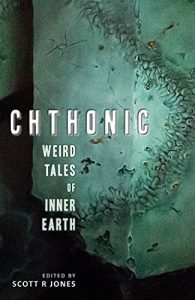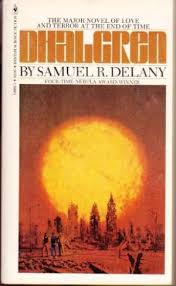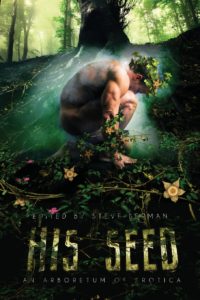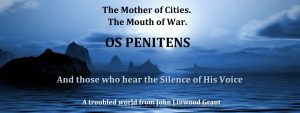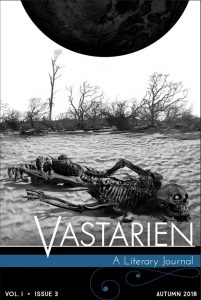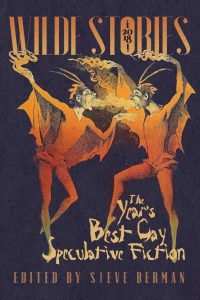John Linwood Grant is often described as the rusty, badly painted tractor of modern weird fiction – he may occasionally plough a straight furrow, but will as often crash into neighbouring fields and spin his wheels just for pleasure. Or something like that. Today on greydogtales, as he fired questions about scary fiction and LGBTQ+ issue at so many innocent authors during January, he must now pay the price and give his own answers. It’s only fair. He even talks about writing in general – and a sort of life…
HIMSELF

greydog: Hi, John, and welcome to greydogtales. We have a feeling we’ve seen you before, but never mind. You can’t be anyone important, or we’d have heard of you. Obviously we’re going to ask about LGBTQ+ writers and characters in strange fiction, but maybe first you could tell the readers a bit about yourself, to set the scene. And if you wanted to share your personal identity in the context of this feature, how would you do so?
John: I’m from Yorkshire, UK, and I’m a working writer/editor – by which I mean that my partner pays most of the bills. The writing is mostly a pleasure; the editing mostly a horror, but as you get older, you don’t let opportunities pass. They may not come again.
As for my identity in LGBTQ+ terms, I’ve never known how to define myself, or worked out why I should, so I don’t bother. A ‘colourful past’ is the best I ever came up with, though I’m certainly male. And I’m all for older people being sexual animals, but with my lower back, well…
When I was at school, I had mad crushes at the same time on Juliet Harmer from the Adam Adamant TV series, and Mike Holoway from The Tomorrow People, which tells you how random I was. I’m not sure that sexual orientation is entirely static for some. I have friends whose orientation is constant and an integral part of their whole persona (straight or otherwise), and I respect that. I also know others whose feelings about their identity and choices have varied across a range over many years.

A number of my straight friends have (grown up) gay, bi or lesbian children, and they’re great kids – they make me feel more positive about our future as an inclusive society, and my place in it. My general view is that if you love them, stop trying to ram them into categories. They’ll say if they want.
greydog: How do you describe the bulk of your own work – horror, weird fiction, magical realism, speculative, or what? Would you find ‘horror’ an uncomfortable or inappropriate label?
John: I’ve no problems with some of my writing being called horror, but I’d say dark and weird are better descriptors. Horror fans might be disappointed by some pieces; non-horror fans would certainly be a bit worried (or appalled) by other stories. How someone turns their head, how they hold their hat or move a chess piece, can be far more interesting than the same old axe murderer crashing through the door and grunting threats at you.
I shift genres and styles when it suits, but ‘strange’ and ‘humane’ are two regular elements of my work. I find people fascinating, so I’m predominantly a character writer, rather than a tidy genre guy.
greydog: And what’s your preferred format and length as a writer – flash fiction, short story, novella, novel, or even book series?
John: Although I’ve written all of them, novelette to novella length is the comfy zone. An awful lot of my stories end up at seven to twelve thousand words, and then I have to chop a number of them for the markets. I have a tendency to to include observations and character interactions not strictly related to the plot, because for me, I’m watching them as human beings, with all their trivia. But I’ve been fortunate in having a number of editors and publishers who’ve let me get away with the longer versions.
Novels can be rewarding, but I find them a chore; I looked at an unpublished novel of mine the other day, and realised that it’s already three hundred pages long and not even tidily finished yet. The editing a novel needs is always more than you thought. Very short pieces, on the other hand, rarely give me room to let my characters breathe, so I don’t do commercial flash fiction. Vignettes I reserve for characters like Mr Bubbles, the slightly psychotic pony, and Mamma Lucy, the conjure-woman, because those pieces are really incidents, meditations, or jokes, related to a single, already established figure.
greydog: Were there key books and films that influenced and helped you develop as a creator? Did they include LGBTQ+ works and/or characters – and if not, did this bug you?
John: I was forged by writers like Enid Blyton and Agatha Christie; William Hope Hodgson, Conan Doyle and Shakespeare; Jane Austen, Michael Herr and James Thurber. And many more. I don’t mean that in a clever way – I was just a precocious kid with voracious and eclectic reading habits, so I’d pick any of those up and enjoy them.
In my teens I read enormous amounts of SFF (not so much horror) – Ursula LeGuin’s Left Hand of Darkness was probably my first fictional introduction to exploring gender identities. I subsequently devoured Samuel Delaney’s Dhalgren, and William Burroughs – Wild Boys, for example. It’s curious that Dhalgren, a very odd book, is still a favourite for both myself and my (female) partner.
Otherwise, there were few LGBTQ+ protagonists in what I read. I don’t think it bugged me as such, but there was a lot of denial going on in the society around me anyway, and I always had the feeling that change was coming. It did, mostly.
greydog: Being realistic, there are times when many of us compromise, and times when we lose our cool. Have you ever dialled down the queer aspects of a piece to try and draw in a wider audience? Or dialled it up on purpose, to hammer a point home?
John: I’’m an egalitarian writer – whatever turns up in my head turns up, whether straight or queer. Straight characters probably predominate statistically (I’d have to count), but sometimes I just don’t indicate. Readers can make their own decisions. I have actually been asked to dial up the gay content on a couple of pieces, where I’d originally left matters as slightly ambiguous. I quite like ambiguous, because it gives you so much room with which to play, but I’ve cheerfully written (and had published) stories with most sexual identities and orientations.
My characters come to me with their own realities, so if they’re straight, gay or lesbian, for example, they just are. I find I can’t ‘make’ a character change their orientation, even if I wanted to. For example, I recently wrote a nineteen sixties carnival story for Planet X, and the protagonist was gay. But I wasn’t looking for a gay character for any overall purpose at all. He turned up in context, and stayed. Forcing him to be straight would have wrecked the story, and made me have to start again from scratch. One of my dark fantasy characters, Malyse anBaralte, turned out to be lesbian because I ‘saw’ her in her work as a magistrate, and knew she would fancy one of the female myrmidons used to enforce the law, a rangy blonde woman with a broken nose. To me it was obvious. And I conceived of Malyse about twenty five years ago.

greydog: When it comes to LGBTQ+ characters in your work, do you tend to depict particular identities – lesbians, gay men, bisexuals, transsexuals – any primary group that comes up in your writing more often than others?
John: The answer’s above, really, apart from the fact that I’ve never written about transsexual individuals, purely because such a character hasn’t cropped up in my head yet. I spent a lot of time in the SF fan community in the UK during the eighties and nineties, where a number of transexual folk were both present and welcome, so I never thought of it as strange – but writing from their viewpoint is obviously a bit further outside my direct experience. I enjoy writing what I ‘don’t know’, but it requires a lot of sensitivity and sometimes a lot of research. Never take other people’s positions, difficulties and choices for granted.
greydog: We were at an interesting panel during the 2018 UK Fantasycon, which included discussion of asexuality in fiction as part of the diversity spectrum. Have you ever covered characters who specifically identified as asexual?
John: Yes, but in rather different ways. In my dark and complicated Os Penitens world of sarcomancers, I have a major character (Hereyl), who chooses quite deliberately to be stripped of the lot – all sexual identity, inclinations and identifiers – to escape their former existence in a warped gens. Their utter asexuality in every sense is the badge of their triumph over their past. And in a Lovecraftian story soon to be published, ‘Strange Perfumes of a Polar Sun’, the protagonist is an asexual woman, but the reader will have to decide if that’s from nature or nurture.
greydog: Which piece of your own work are you most proud of, and why?
John: Possibly my portrayal of Edwin Dry, the inexorable Deptford Assassin, in various stories and in my novel The Assassin’s Coin. He spans the late Victorian and Edwardian eras, and has been called “one of the most ghastly characters in modern strange fiction” and “one of the most evocative presences in modern dark fiction – precise, relentless, inexorable.” All of which is perhaps over-generous, but it is rather gratifying, taking such a character from conception to being a living, breathing figure who worries people.
As for individual pieces, I’m fairly proud of getting into the Vastarien journal with my story ‘For She is Falling’, primarily because when you write across genres like I do, it can be hard to get acceptance as a serious writer in any particular field. Especially as I also enjoy writing Sherlock Holmes pastiches, and have had a number published. Pastiches are popular, but if you’re not careful, you can get labelled with them quite quickly.
I suspect that some people don’t even know that I write modern weird fiction, but there I’m in a different head-space from my late Victorian and Edwardian tales. Maybe I should have created a number of unlikely pseudonyms for each branch before I started? Then people who like thrilling or scary Edwardian tales wouldn’t have to wonder what the hell the rest of my work is about.
LGBTQ+ FICTION & THE FIELD
greydog: The most common phrase you hear when people object to active movements which encourage diversity in fiction is “I don’t care about the sexuality, gender, colour, etc. of the writer. I only care about good stories”. How would you respond to that?
John: I would respond carefully, because I might have thought that way myself once, believing it to be an inclusive and positive statement. And I think it can be genuinely meant well by some people. Only as you age and learn do you begin to see the flaws in it – that it’s an easy statement if it comes from those who have a dominant or privileged position and can afford to see it that way. If you have a background of being or of feeling excluded – on the basis of gender, skin colour, sexual orientation etc – then it starts to look different.
We won’t ever hear some stories, some stunning and fascinating ones at that, if we don’t actively seek their creators out, if we don’t give a greater say to a broader and more diverse range of writers. And what we encourage and support now is what our kids, or our friends’ kids will be able to read. So maybe we have to care, until the genres are so richly endowed by voices from everywhere that we no longer need to be as concerned.
greydog: ‘Straight’ is a silly term in many ways, but we’ll use it for shorthand. A number of straight creators utilise LGBTQ+ characters in their work. Do you see any inherent problems with this, or is it a good way of getting audiences to broaden their minds and reading scope. Are there any common misconceptions which get transmitted by straight creators?
John: I’m all for more LGBTQ+ characters just being there in fiction. Anywhere. As leading protagonists, villains, love interests, mad scholars, helpful posties, and unimportant pedestrians on the street. The person who comes to read the gas meter. In any and every role in fiction. So I’m for it, basically. And I like to see such characters presented without it always being about their sexual orientation and/or problems in that area.
In a related way, I recently finished a story with a key character in a wheelchair. That was how I saw him – but there’s no explanation of how it came about, nor does it impact on the story particularly. He’s not there to explore ability and disability – he’s there because that’s who he was when I thought the story up one night. Don’t get me wrong, I’m not at all against stories which revolve around personal trauma and the impact of people’s prejudices, I just don’t think that’s always got to be the point.
Two aspects where I see slight problems are a) when an author tries use or explore areas such as gay communities/social networks, without understanding the nuances involved, and b) when an LGBTQ+ character has been parachuted in as PC eye-candy, or to be exploded late in the book for effect. “Goodness, the tough lesbian sacrificed herself for us. Now let’s get on with our lives.” That’s already been done quite enough, thank you, with so many poor bloody black characters who have died in films in order to let the white couple float to the surface and have a happy ending.
greydogtales: Do you think LGBTQ+ fiction is more acceptable to a lot of straight readers when it comes from ‘nice middle-class white people’, as opposed to when it comes from additionally marginalised groups such as queer black writers?
John: I suspect so. It makes me think of earlier British sitcoms, where there could be a loveable, funny gay guy (rarely a lesbian) – the ‘acceptable’ face of LGBTQ+. They were white, middle-class, and ‘not so different from you and me’, so they could come into the living room without mutters and awkward looks. Just a joke here and there, but no rancour. People are strange in how they absorb ‘the other’ into their own narratives.
greydog: How should the big publishers and larger independents be fostering LGBTQ+ fiction and portrayals? Or is it purely up to readers to express a demand?
John: Both – but for the right reasons. It should be part of the search for, and support for, strong fiction with great characters from authors who may have been or felt marginalised, not merely to tick the Ten Percent LGBTQ+ Content Box for Head Office and the PR Department.
greydogtales: There are a number of presses dedicated to LGBTQ+ fiction. Do you view these as a good thing, or do you think they risk perpetuating exclusion from mainstream presses?
John: I think they’re essential, and have many roles. In some cases they’re the starting point, where LGBTQ+ writers can safely explore what they want to communicate, or they’re presses which understand how to promote a work to a primary audience. They may also take the sort of risks which larger presses won’t. But I’m a great supporter of small and independent presses in general, because many of them actively seek out strange and different fiction in many areas which would otherwise be called ‘niche’. I’ve worked most often with Steve Berman‘s Lethe Press, which is very cool.
greydog: Do you have a favourite line or passage from your own work, or from that of another LGBTQ+ creator, that you’d like to share?
John: I’ve read some great stuff by LGBTQ+ creators in the last few years, but can’t think of a way of naming some and not others. Maybe a different time – although the LGBTQ+ January was designed to share some names and voices, in conjunction with Gingers Nuts of Horror, who psoted some fascinating articles, so you can check those out.
To make things easy for me, I’ll simply share a passage from a weird novelette of mine that hasn’t yet found a home, ‘These Pale and Fragile Shells’. I mention it because the story includes gay, lesbian, straight and fluid characters as a natural part of a social circle, not to make any sociopolitical point – unless you include any subtext that you can be whatever you want if you have money. The narrator is Justin Margrave, a gay art critic in the late nineteen seventies.
Paul Iscariot was an artist – or an artisan. The point was moot. None of us believed that Iscariot was his real name, of course. His supposed upbringing on the Sussex Downs seemed unlikely, and Oxford had no details of his graduation, though he had been admitted there; the St Martin School denied he had ever been with them.
We did believe his stories of India, on the other hand, because others had seen him. Iscariot went there to work in a village of artisan sculptors, of interest to him because they worked only with chalk. For over a year he had learned the finest techniques, carving devotional figurines and temple adornments alongside men who spoke no English.
We called Iscariot the Artist of the White Powder, for he ran on chalk and cocaine, a stranger to to sobriety. I met him for the first time in nineteen seventy three, when he was being thrown out of a Soho gallery. Recognising him from the magazines, I plied him with questions in a wine-bar, and we had sex at my flat that afternoon. Or we would have. His approach to lovemaking was as bedevilled with minutiae as his work – I abandoned ship after an hour and left him to finish himself off.
After that our contact was intermittent, though I wrote a couple of articles on his work. ‘The confused child of netsuke and scrimshaw,’ I called it in one journal. Iscariot, in a drunken rage, threw stones at their offices, yet the next day he invited me to lunch, during which he talked of nothing but Celtic knotwork…
greydog: And what have you planned in the way of work for 2019?
John: A second edition of my collection A Persistence of Geraniums, with considerable extra material; an audiobook of The Assassin’s Coin; the Hell’s Empire anthology from Ulthar Press; Sherlock Holmes and the Occult Detectives from Belanger Books, and some more work for 18thWall Productions.… it’s all very confusing. And probably something – I have no idea what – to do with the wryly insane East Yorkshire village of St Botolph-in-the-Wolds.
greydog: John Linwood Grant, many thanks for taking part.
John: Who are you, and what are you doing in my living room?
THE ASSASSIN’S COIN
“With elegant, effortless prose, John Linwood Grant has created a compulsively readable work of eerie suspense. In his stark and sinister Victorian England, a resourceful heroine must pit her psychic gifts against the dangerous skills of a chilling assassin. Grant has achieved something altogether rare: a genuinely unique take on the Jack the Ripper murders, in which the famous killer is actually upstaged by the author’s original creations. With its compelling premise, memorable characters, and thrilling suspense, you’ll be haunted by The Assassin’s Coin for a long time to come.” —Amanda DeWees, author of A Haunting Reprise and The Last Serenade
